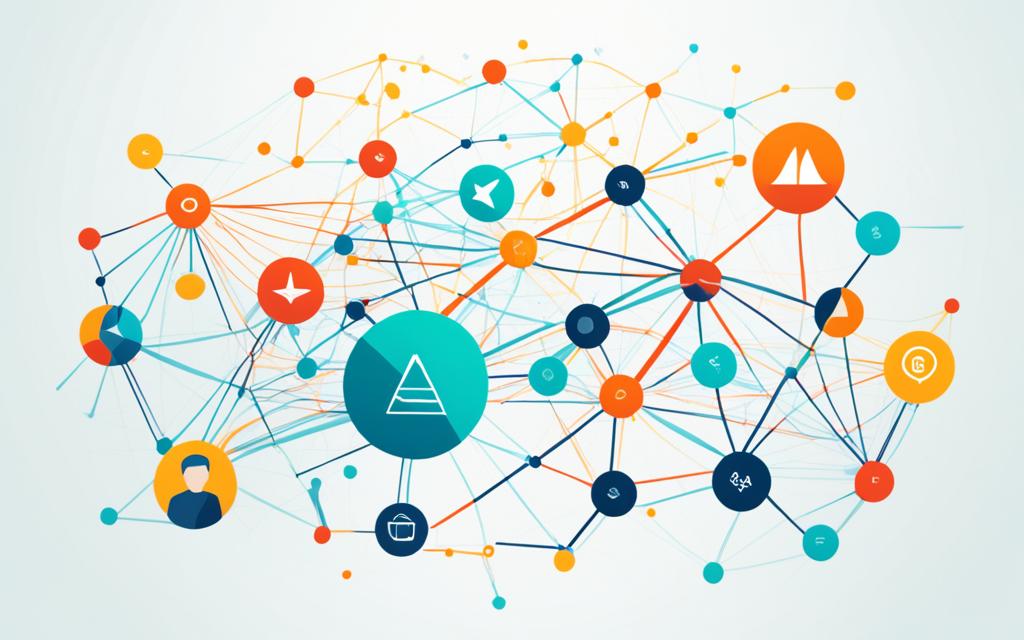CPM networks, also known as Critical Path Method networks, are key in project management. They help figure out the most important steps to know how long a project will take. Many things are said about CPM networks, but it’s vital to know what’s true and what’s not. This article will clear up any confusion and give you the facts1.
Key Takeaways:
- CPM networks, also known as Critical Path Method networks, are extensively used in project management.
- They help determine the critical steps and duration of a project.
- Separating myths from facts is crucial when discussing CPM networks.
- In this article, we will clarify misconceptions and provide factual information about CPM networks.
- Stay tuned to learn the true statements about CPM networks!
What is an Embedded System?
An embedded system is a special kind of computer that is part of a bigger machine or electrical setup. It does one main job, like controlling a printer or a car’s engine. You can find these systems in many things, like home appliances, cars, and medical devices. They have a microprocessor or microcontroller, memory, and ways to input and output data.
Microprocessors are general-purpose chips that need extra memory and ports. Microcontrollers have everything on one chip. When picking a microcontroller, think about speed, memory, I/O pins, cost, and power consumption. Embedded systems are key to many modern tech advances.
These systems have limited resources like power and memory2. They focus on being reliable and stable for important tasks where problems could be very bad2. There are different kinds of embedded systems, like ones that work alone or connect to networks2.
- Computers are more complex than embedded systems2.
- Computers use more power than embedded devices2.
- Buying a computer costs more than an embedded system2.
- Embedded devices work on their own without needing human help2.
- Computers have things like keyboards, while embedded devices have special interfaces2.
- Computers can be changed for new uses, but embedded devices are made for one job2.
- Computers stand alone, but embedded devices are part of other systems2.
- Computers are bigger than embedded devices2.
Knowing about embedded systems is important today. For more on the differences between computers and embedded systems, click here. For a full look at embedded systems, check this link .
Embedded system projects are sorted into different groups based on size and other factors3. About 10.3% of planning for these projects focuses on size, and 27.5% are development projects needing special tech skills3. Projects are also sorted by strategic value, with 18.1% looking at how much change they bring3. Routine projects make up 14.6%, being simple and following set steps3.
Stakeholders are key in 20.4% of project classifications, showing how important they are3. Research projects, at 16.2%, aim to explore new ideas or concepts3.
Implementing the Critical Path Method: Drawbacks and Solutions
The Critical Path Method (CPM) is a key technique in the construction world4. Yet, it’s not without its problems. Project managers often face hurdles that can affect how well the CPM works and the project’s success. It’s important to know these issues and find ways to fix them.
One big issue is that field managers might not use the CPM as planned. They might prefer quick, informal plans over the detailed CPM ones4. This can make the critical path analysis less important, hurting the project’s schedule management.
Keeping the project plan up to date is another challenge. It’s key to update the critical path regularly4. But, this takes a lot of work and resources.
Older problems with CPM include not understanding it well and poor schedule quality4. These issues are still there, showing the method’s limits. To get past these, we need to add features that work better with construction’s changing nature and make it easier to use.
Using project management software can help with CPM’s problems. These tools make updating schedules and analyzing the critical path easier4. This means project managers can quickly adjust the plan when things change, keeping the schedule accurate and avoiding delays.
Teaching project teams about the Critical Path Method can also help4. When they understand its value and how it affects the project, they can use the critical path better. This helps with successful use of the method.
In summary, the Critical Path Method is a great tool, but it has its challenges. By using project management software and teaching teams, we can make it work better in construction projects4. This leads to better task prioritization, realistic schedules, and fewer delays, improving project results.
Understanding the Critical Path Method
The critical path method (CPM) is a key project management tool. It helps estimate project times and ensure projects finish on time5. Created in the late 1950s, CPM finds the critical tasks that affect the project’s timeline and length6.
With CPM, managers can make a detailed schedule to finish projects on time and within budget5. It’s especially useful for projects with tasks that depend on each other. It spots bottlenecks and makes sure resources are used well5. Finishing critical tasks on schedule is key to avoiding delays and keeping the project moving5. Non-critical tasks can be scheduled more freely and are less likely to cause delays5.
CPM’s big plus is its ability to show project timelines with flowcharts5. These charts help teams understand the order of tasks and how they depend on each other5. It also helps spot and fix risks, cutting down on downtime and costs5.
Good communication is key to managing projects well, and CPM helps by making the project timeline clear5. It also lets teams figure out the slack time for each task7. Tasks with no slack can’t be delayed without affecting the project, while others might have slack, giving more flexibility57.
To keep the project on track, it’s important to regularly check on critical tasks5. These tasks are the heart of the project5.
In summary, the critical path method is a powerful tool for managing projects. It helps estimate project times and use resources well5. By understanding the critical path and using CPM, managers can improve project schedules, keep an eye on progress, and deliver projects successfully6.
Steps to Find the Critical Path for Your Project
Finding the critical path for your project takes a few steps. First, list all the tasks–project tasks needed to finish the project. This list is key for critical path analysis.
Next, set up task dependencies. These define the order tasks must be done in. Some tasks wait for others to finish, while some can be done at the same time. Knowing these dependencies helps you plan a logical order to finish the project7.
After setting dependencies, figure out how long each task will take. Use the earliest start (ES) and earliest finish (EF) dates to find the critical path. The critical path has tasks with no float, meaning their dates are set and delays affect the project’s end7.
Floats like total and free float show how flexible tasks are. Total float is the time between the latest and earliest dates for a task. Free float is the time before the next task starts. These floats help plan for delays or changes7.
Watching the total float helps managers keep projects on time. It shows if the project might finish early or late. Floats help managers plan and use extra time for risks or surprises7.
To speed up projects, use techniques like fast tracking and crashing. Fast tracking does tasks at the same time. Crashing adds more resources to key tasks to finish faster7.
The Critical Path Method (CPM) mainly looks at time, not resources. But when resources are short, use leveling to schedule tasks well. Leveling helps manage tasks even when there’s not enough people or equipment7.
Tools like Jira or TeamGantt help with the critical path. They show task dependencies, track progress, and help with planning. These tools help managers keep their projects on track7.
By following these steps and using tools, you can manage your project’s critical path well. Knowing the critical path keeps you on track, meets deadlines, and leads to success.
Monitoring the Critical Path with Project Management Software
Project management software is key in keeping an eye on the critical path of a project. Tools like Jira, Mavenlink, and TeamGantt help project managers track and see the critical path. This ensures the project does well.
These tools let you make Gantt charts. These charts show the project schedule and highlight the critical path and non-critical tasks. Knowing the critical path helps managers spot bottlenecks and use resources well8.
Project management software also lets managers set task dependencies. These ensure tasks are done in the right order. This reduces delays and makes projects more efficient. By knowing these dependencies, managers can see how tasks affect each other and the project timeline8.
Due dates are another important feature. They act as milestones to keep teams on track. Setting and tracking due dates helps managers make sure tasks are done on time. This keeps the project moving smoothly8.
With this software, managers can always keep an eye on the critical path. They can make changes as needed to keep the project on track. This includes moving resources, changing task dependencies, or adjusting due dates8.
Benefits of Monitoring the Critical Path with Project Management Software
Using project management software to watch the critical path has many benefits. These include:
| Benefits | Description |
|---|---|
| Optimal Resource Allocation | This software helps managers use resources well by focusing on the critical path. It makes sure the right people are on the right tasks8. |
| Enhanced Risk Mitigation | By tracking the critical path, managers can spot high-risk tasks early. This helps them take steps to reduce risks and avoid delays8. |
| Informed Decision-Making | Having real-time updates on the critical path helps managers make smart choices. They can decide on task priorities, resource use, and deadlines8. |
| Efficient Communication | This software makes it easy for team members to talk about critical tasks. It’s a central place for updates and discussions8. |
| Cost Efficiency | Managing the critical path well helps avoid extra costs from delays. This keeps projects on budget8. |
| Strengthened Team Collaboration | Keeping an eye on the critical path encourages teamwork. It helps create a united and effective team8. |
| Consistent Project Delivery | By tracking the critical path and ensuring tasks are done on time, managers can deliver projects on schedule8. |
In short, project management software gives managers the tools to handle the critical path well. Features like Gantt charts, task dependencies, and due dates help track the path in real-time. This leads to better decisions and successful projects. Using this software is key for any organization aiming for top project results8.
Critical Path Method and Resource Allocation
Resource allocation is key in managing a project’s schedule with the Critical Path Method (CPM). If a project is running late, managers might add more resources to important tasks to speed things up. This is called crashing. It means moving resources from less important tasks to those that need it most.
Crashing helps managers focus on key tasks to keep the project on track. By moving resources around, they can shorten the critical path and get the project back on schedule. But, managers must think about how crashing affects the project overall.
The goal of resource allocation is to make the project schedule better by using resources well. It means putting resources in the right places based on what they can do and what they need. Getting this right is important to avoid delays and finish critical tasks on time.
“Proper resource allocation is the key to maintaining project timelines and meeting project goals.”
Managers need to look closely at the critical path to see where they need more resources. By putting resources in these key areas, they can make the project shorter.
But, managers also have to think about how taking resources away from less important tasks affects them. Taking away resources can delay or lower the quality of these tasks. It’s important to weigh the pros and cons to keep the project balanced.
Good resource allocation needs a deep understanding of the project’s needs, what resources are available, and how tasks depend on each other. Tools like project management software can help by showing how different resource allocations change the project schedule.
By making the most of resource allocation and managing the critical path well, managers can finish projects on time and meet what stakeholders expect. The Critical Path Method, with smart resource allocation, helps managers deliver projects on time and within budget.
Benefits of Effective Resource Allocation in the Critical Path Method
Using good resource allocation in the Critical Path Method brings many benefits:
- Optimized project schedule: By using resources wisely, managers can cut delays and make the project run smoother to hit deadlines.
- Enhanced project visibility: Resource allocation helps managers see what tasks are most important and where to put resources, making the project’s progress clear.
- Improved decision-making: Looking at different resource scenarios helps managers make better choices for using resources, which boosts the project’s performance.
- Maximized resource utilization: Putting resources in the right places makes sure they’re used well, avoiding delays and boosting productivity.
When done right, resource allocation in the Critical Path Method can really help a project succeed. It lets teams finish projects on time and within budget.
| Resource Allocation Best Practices | Key Considerations |
|---|---|
| 1. Prioritize critical tasks when allocating additional resources. | |
| 2. Assess the impact of resource allocation on non-critical tasks. | |
| 3. Use project management software to analyze resource allocation scenarios. | |
| 4. Regularly review and adjust resource allocation based on project progress and changing requirements. |
By following these best practices and using the Critical Path Method, managers can manage resources well, avoid delays, and ensure projects succeed.
The Importance of Project Understanding in Critical Path Analysis
Project understanding is key to doing well in critical path analysis in project management. It means getting a full view of things like resources, schedule, and risks that affect the project. We’ll show why understanding the project is so important for a successful critical path analysis.
Optimizing Resource Allocation
Knowing what resources a project needs helps managers use them better. The Critical Path Method (CPM)9 helps find the most important tasks. Managers can then focus on these tasks and use resources wisely to hit project goals on time.
Accurately Determining the Schedule
Understanding the project helps managers set a realistic schedule. The CPM process includes steps like making a list of tasks and updating the network diagram9. This leads to a schedule that’s realistic and helps in planning and using resources well.
Predicting and Mitigating Risks
Knowing the risks in a project lets managers deal with them before they become big problems. CPM gives a timeline for finishing the project5, helping managers see and tackle risks early. Planning and using strategies to reduce risks helps avoid delays and ensures the project succeeds.
Enhancing Team Collaboration
Understanding the project helps teams work better together. With a clear view of what needs to be done and how it fits together, team members can work smoothly. CPM makes communication better by showing the project timeline and critical path5. This leads to better teamwork and efficiency during the project.
In summary, getting a deep understanding of a project is vital for a successful critical path analysis. Knowing about project needs, resources, schedule, and risks helps managers use resources well, set realistic schedules, handle risks, and improve teamwork. This knowledge is the base for doing critical path analysis well, leading to more efficient and successful projects.
Critical Path Method and Project Risk Management
Risk management is key to making a project a success. The critical path method (CPM) works hand in hand with it. It helps in planning and managing resources. By using the critical path and risk management together, managers can lower risks and keep projects on track.
The critical path method finds the key activities that must be done to finish a project on time. It helps managers spot risks that could delay the project and plan for them10. By looking at each task’s time and how they depend on each other, managers find the critical path. This shows the shortest time needed to finish the project. It helps in planning resources better and setting priorities.
Combining the critical path with risk management helps control projects better. Managers can see which tasks might be delayed and plan extra resources or backup plans10. This way, they can lessen risks and avoid delays and cost overruns. They can spot potential problems early and act on them to keep the project on track.
The critical path also helps compare planned project times with how things are going. By tracking progress and spotting any schedule changes, managers can make smart choices to fix risks and plan better for the future11. It gives insights on managing resources, helping in deciding which tasks to focus on and how to use resources well. This cuts down on waste and improves project results.
Remember, the critical path method fits best in the project’s life cycle. It’s especially useful for big and complex projects12. By using statistical tools like the Beta distribution in PERT charts, managers can better understand the uncertainty in task times. This helps in making smart risk management decisions12. Knowing about float helps in managing cash and inventory, which also boosts project risk management12.
In the end, the critical path method and project risk management work together to make projects successful. By using the critical path insights and risk management, managers can spot and reduce risks. This ensures projects finish on time and within budget.
Conclusion
CPM networks, also known as the Critical Path Method, are key in project management. This article has shown us the real value and limits of CPM networks. It helps project managers plan, schedule, and keep an eye on their projects for success.
Recent stats13 show worrying trends in pregnancy-related deaths and severe health issues. Healthcare must focus on preventing and managing these problems. The data14 also stresses the need for tools like Gantt charts in project management. These tools help managers see tasks, track progress, and hit milestones on time.
Using the Critical Path Method and tools like Gantt charts helps project managers tackle project planning and execution clearly and efficiently. With a deep understanding of CPM networks, project managers can lead their teams to success with confidence.
FAQ
What are CPM networks?
CPM networks, also known as Critical Path Method networks, help figure out the key steps in a project. They show how long a project will take to finish.
What is an embedded system?
An embedded system is a computer that does one specific job in a bigger system. It can be in things like appliances, cars, or medical devices. Its main job is to control something, like a printer or a thermostat.
What are the drawbacks of implementing the Critical Path Method?
Some challenges include not being used much by field managers and being hard to update. These problems can be fixed by adding features that work better with the changing nature of construction projects.
What is the Critical Path Method?
The Critical Path Method is a way to figure out how long a project will take. It started in the 1950s to solve delays in the U.S. Navy’s ballistic missile program.
How do I find the critical path for my project?
First, make a list of all the tasks needed for your project. Then, figure out which tasks depend on each other and how long each will take. Finally, find the critical path, which is the longest chain of tasks that sets the project’s overall time.
How can project management software help monitor the critical path?
Tools like Jira or TeamGantt have features like Gantt charts and task dependencies. These help project managers see the critical path and keep track of progress.
What is resource allocation in relation to the critical path?
Resource allocation means giving more resources to important tasks to finish the project faster. This is called crashing. It helps complete critical tasks on time without hurting the project too much.
Why is project understanding important in critical path analysis?
Understanding your project helps with better resource use, risk reduction, and success. It’s key for managers to know all the details and analyze them well before doing critical path analysis.
How is the Critical Path Method related to project risk management?
Identifying the critical path helps managers spot risks that could delay the project. By managing these risks, they can keep the project on track and avoid extra costs or delays.
Source Links
- https://www.proprofs.com/quiz-school/story.php?title=imcc – Nursing Informatics Questions And Answers
- https://www.geeksforgeeks.org/difference-between-computer-and-embedded-system/ – Difference Between Computer and Embedded System – GeeksforGeeks
- https://ezexplanation.com/nec/exam/content/103-project-planning-and-scheduling/ – EzExplanation Computer engineering web Tutorial
- https://www.smartsheet.com/content/critical-path-advantages-disavantages – Advantages & Disadvantages of Critical Path Method | Smartsheet
- https://www.wrike.com/blog/critical-path-is-easy-as-123/ – The Critical Path Method in Project Management: A Full Guide
- https://www.projectmanager.com/guides/critical-path-method – Critical Path Method (CPM) in Project Management
- https://asana.com/resources/critical-path-method – Use Critical Path Method (CPM) for Project Management [2024] • Asana
- https://www.goskills.com/Project-Management/Resources/Critical-path-method-project-management – How to Use the Critical Path Method for Better Project Management
- https://acqnotes.com/acqnote/tasks/critical-path-critical-path-method – Understanding the Critical Path Method (CPM) – AcqNotes
- https://www.proprofs.com/quiz-school/story.php?title=otewotc0b7vt – PERT And CPM Quiz Questions With Answers
- https://www.simplilearn.com/tutorials/project-management-tutorial/critical-path-method – What Is Critical Path Method (CPM) | Simplilearn
- https://testbook.com/objective-questions/mcq-on-pert-and-cpm–5eea6a0e39140f30f369e4d7 – [Solved] PERT and CPM MCQ [Free PDF] – Objective Question Answer for PERT and CPM Quiz – Download Now!
- https://www.acog.org/clinical/clinical-guidance/obstetric-care-consensus/articles/2019/08/levels-of-maternal-care – Levels of Maternal Care
- https://www.atlassian.com/agile/project-management/gantt-chart – Gantt Charts | Atlassian



















